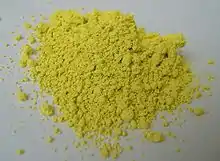Titanium yellow
Titanium yellow, also nickel antimony titanium yellow, nickel antimony titanium yellow rutile, CI Pigment Yellow 53, or C.I. 77788, is a yellow pigment with the chemical composition of NiO·Sb2O3·20TiO2. It is a complex inorganic compound. Its melting point lies above 1000 °C, and has extremely low solubility in water. While it contains antimony and nickel, their bioavailability is very low, so the pigment is relatively safe.
| Titanium yellow | |
|---|---|
 Commercial pigment | |
| Hex triplet | #EEE600 |
| Source | [Unsourced] |
| Names | |
|---|---|
IUPAC name
| |
| Identifiers | |
| ECHA InfoCard | 100.029.410 |
CompTox Dashboard (EPA) |
|
| Properties | |
| NiO·Sb2O3·20TiO2 | |
| Appearance | Yellow pigment |
Except where otherwise noted, data are given for materials in their standard state (at 25 °C [77 °F], 100 kPa). | |
| Infobox references | |
The pigment has crystal lattice of rutile, with 2–5% of titanium ions replaced with nickel(II) and 9–12% of them replaced with antimony(V).
Titanium yellow is manufactured by reacting fine powders of metal oxides, hydroxides, or carbonates in solid state in temperatures between 1000 and 1200 °C, either in batches or continuously in a pass-through furnace.
Titanium yellow is used primarily as a pigment for plastics and ceramic glazes, and in art painting.
See also
- List of colors
- List of inorganic pigments